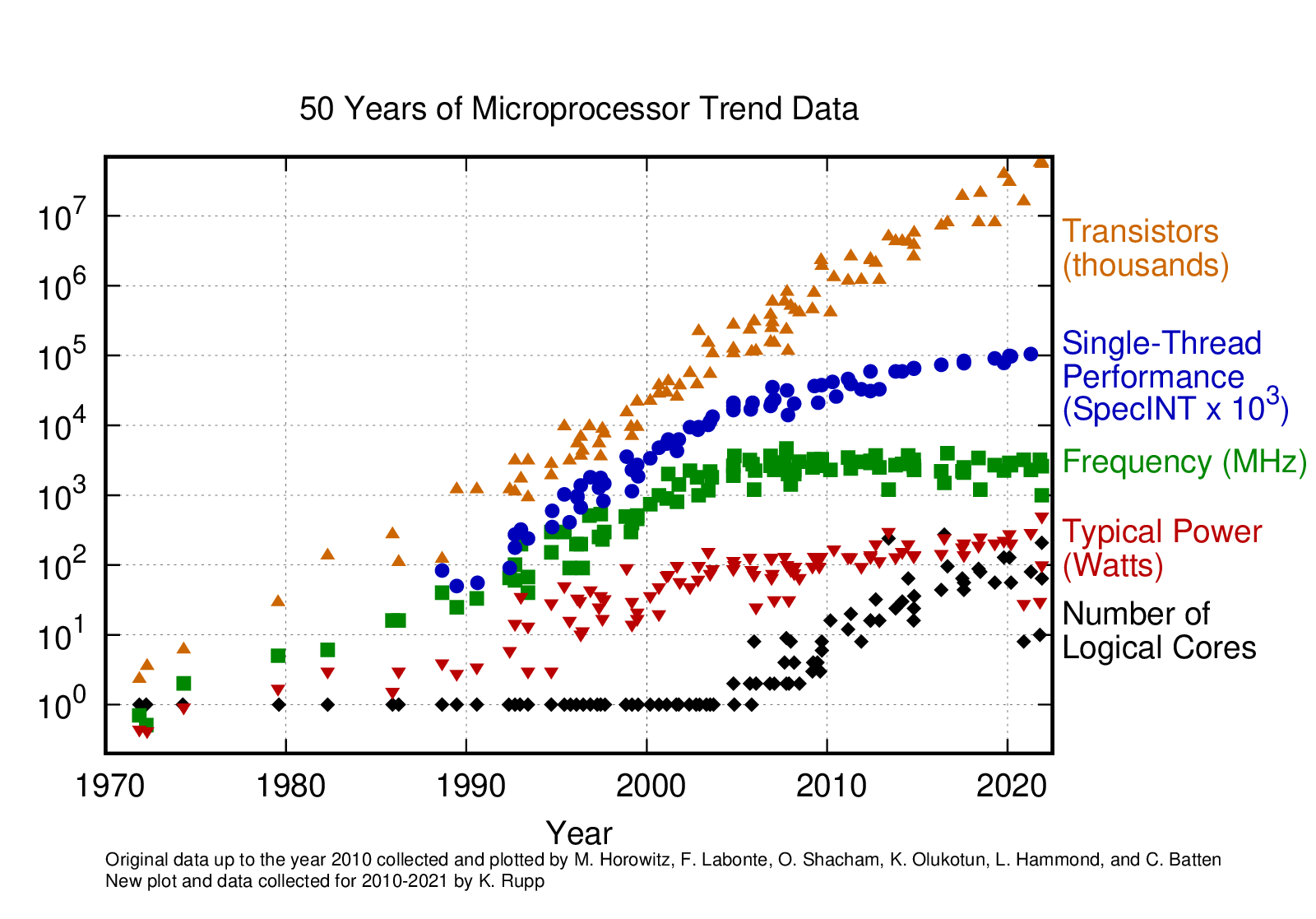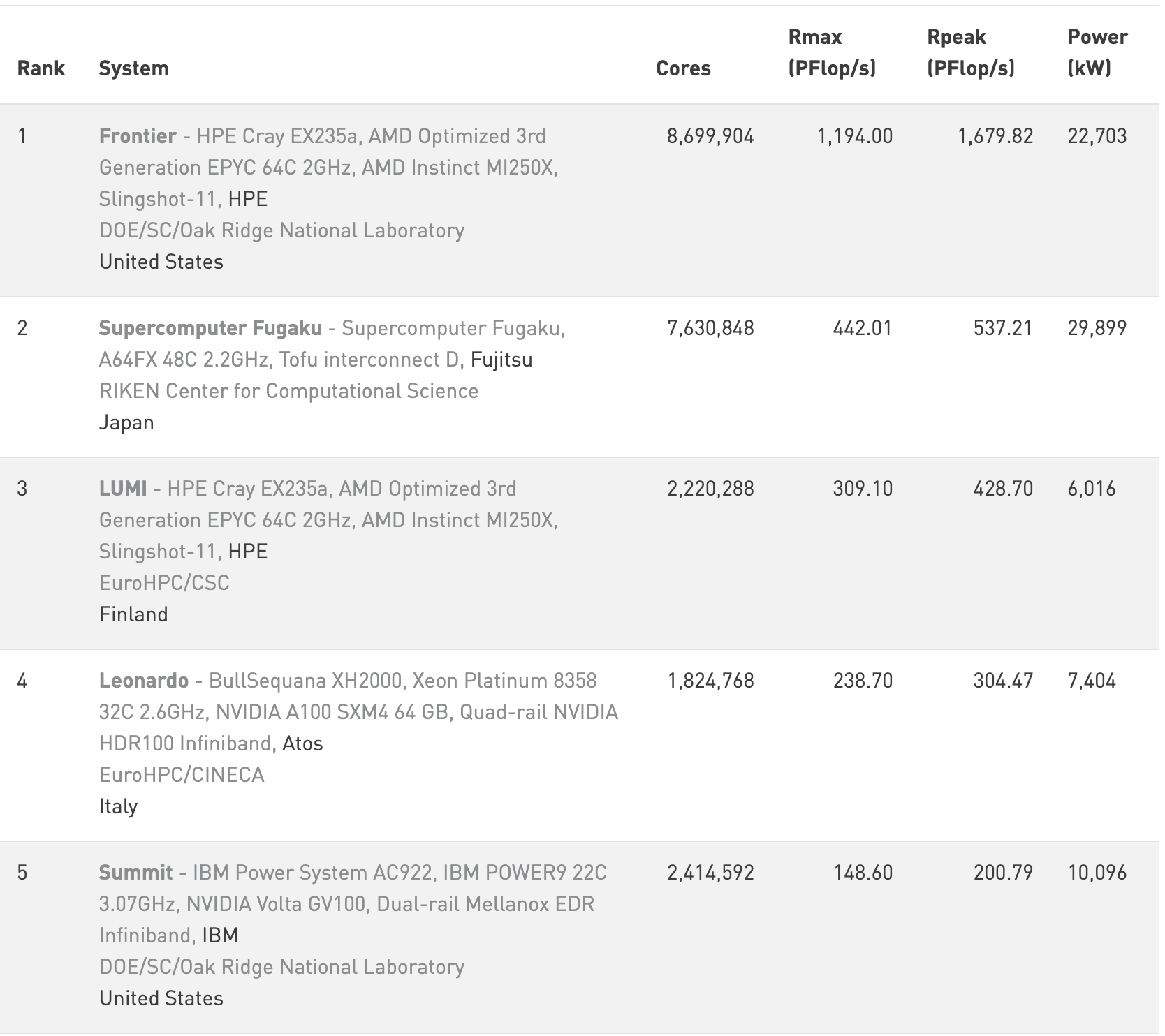Why GPUs?
Questions
What is Moore’s law?
What problem do GPUs solve?
Objectives
Explain the historical development of microprocessors and how GPUs enable continued scaling in computational power
Instructor note
15 min teaching
0 min exercises
Moore’s law
It states that the number of transistors in a dense integrated circuit doubles about every two years. More transistors means smaller size of a single element, so higher core frequency can be achieved. However, power consumption scales with frequency to the third power, therefore the growth in the core frequency has slowed down significantly. Higher performance of a single node has to rely on its more complicated structure and still can be achieved with SIMD (single instruction multiple data), branch prediction, etc.

The evolution of microprocessors. The number of transistors per chip doubles roughly every 2 years. However, it can no longer be explored by the core frequency due to the power consumption limits. Before 2000, the increase in the single core clock frequency was the major source of the increase in the performance. Mid 2000 mark a transition towards multi-core processors.
Increasing performance has been sustained with two main strategies over the years:
Increase the single processor performance:
More recently, increase the number of physical cores.
Computing in parallel
The underlying idea of parallel computing is to split a computational problem into smaller subtasks. Many subtasks can then be solved simultaneously by multiple processing units.

Computing in parallel.
How a problem is split into smaller subtasks strongly depends on the problem. There are various paradigms and programming approaches to do this.
Graphics processing units
Graphics processing units (GPU) have been the most common accelerators during the last few years, the term GPU sometimes is used interchangeably with the term accelerator. GPUs were initially developed for highly-parallel task of graphic processing. But over the years, they were used more and more in HPC.
GPUs are a specialized parallel hardware for floating point operations. They are basically co-processors (helpers) for traditional CPUs: CPU still controls the work flow but it delegates highly-parallel tasks to the GPU. GPUs are based on highly parallel architectures, which allows taking advantage of the increasing number of transistors.
Using GPUs allows one to achieve extreme performance per node. As a result, the single GPU-equipped workstation can outperform small CPU-based clusters for some type of computational tasks. The drawback is: usually major rewrites of programs is required with an accompanying change in the programming paradigm.
Host vs device
GPU-enabled systems require a heterogeneous programming model that involves both CPU and GPU, where the CPU and its memory are referred to as the host, and the GPU and its memory as the device.

Figure adapted from the Carpentry GPU Programming lesson.
A look at the Top-500 list
The TOP500 project ranks and details the 500 most powerful non-distributed computer systems in the world. The project was started in 1993 and publishes an updated list of the supercomputers twice a year. The snapshot below shows the top-5 HPC systems as of June 2023, where the columns show:
Cores - Number of processors
Rmax - Maximal LINPACK performance achieved
Rpeak - Theoretical peak performance
Power - Power consumption

Snapshot from the Top500 list from June, 2023.
All systems in the top-5 positions contain GPUs from AMD or NVIDIA, except for Fugaku which instead relies on custom-built Arm A64FX CPUs.
Why GPUs?
Speed
GPU computing can significantly accelerate many types of scientific workloads.
Improved energy efficiency
Compared to CPUs, GPUs can perform more calculations per watt of power consumed, which can result in significant energy savings. This is indeed evident from the Green500 list.
Cost-effectiveness
GPUs can be more cost-effective than traditional CPU-based systems for certain workloads.
Limitations and drawbacks
Only for certain workloads
Not all workloads can be efficiently parallelized and accelerated on GPUs. Certain types of workloads, such as those with irregular data access patterns or high branching behavior, may not see significant performance improvements on GPUs.
Steeper learning curve
Depending on the GPU programming API that you choose, GPU computing could require specialized skills in GPU programming and knowledge of GPU architecture, leading to a steeper learning curve compared to CPU programming. Fortunately, if you study this training material closely you will become productive with GPU programming quickly!
Keypoints
GPUs are accelerators for some types of tasks
Highly parallilizable compute-intensive tasks are suitable for GPUs
New programming skills are needed to use GPUs efficiently